Grofova Jama
Grotte des Grafen - Grotta del Fuoco - Brezno na Grmadi - Vogenca - Salvator Höhle
Useful Information
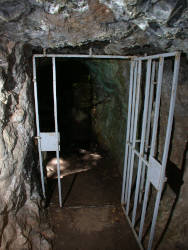
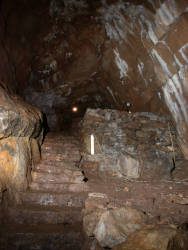
| Location: |
Walking trails from Brestovica pri Komnu in Slovenia and Medeazza or Ceroglie in Italy.
(45.79846755921161, 13.627899697927353) |
| Open: |
Last Sunday every month 15. [2021] |
| Fee: |
donation. [2021] |
| Classification: |
 Karst Cave Karst Cave
 World War I World War I
|
| Light: | electric with generator, bring torch |
| Dimension: | L=226 m, VR=46 m, A=164 m asl. |
| Guided tours: | |
| Photography: | allowed |
| Accessibility: | no |
| Bibliography: |
Nadja Zupan Hajan, Andrej Mihevc, Petr Pruner, Pavel Bosák (2008):
Palaeomagnetism and Magnetostratigraphy of Karst Sediments in Slovenia,
Karst Research Institute, Založba ZRC, paperback • 20 × 27 cm • 268 pages • 282 pictures and 81 plates. ISBN 978-961-254-058-6
online
Nadja Zupan Hajan, Andrej Mihevc, Petr Pruner, Pavel Bosák (2010): Palaeomagnetic research on karst sediments in Slovenia International Journal of Speleology, 39(2), 47-60. Bologna (Italy). July 2010. researchgate |
| Address: |
Grofova Jama, 6223 Brestovica pri Komnu.
Jamarsko društvo Sežana, Bazoviška cesta 9, 6210 Sežana, Tel: +386-51-648-711. E-mail: Jože Terčon, Tel: +386-51-306964. Peter Pipan, Tel: +386-43-405-642. |
| As far as we know this information was accurate when it was published (see years in brackets), but may have changed since then. Please check rates and details directly with the companies in question if you need more recent info. |
|
History
| World War I | part of the Austro-Hungarian fortifications. |
| 29-MAY-1992 | cave rediscovered. |
Description
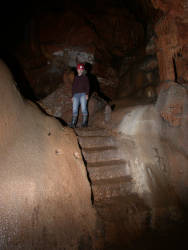
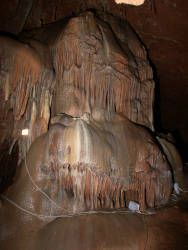
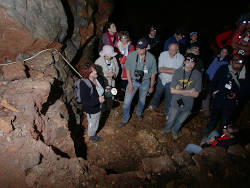
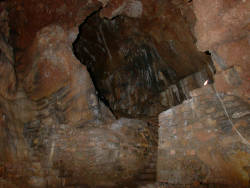
Grofova Jama (Count’s Cave) is a small cave located at the border between Italy and Slovenia. It is also named Brezno na Grmadi (Abyss on Grmada) because it is located on a mountain ridge named Grmada and because it is actually a vertical cave. The cave is mostly vertical, so there are many steep sections, and shafts at various levels. The entrance is gated by an iron bar gate, the a narrow tunnel follows, which is artificial and was built during World War I. Then the descent a long stone staircase starts through the main shaft or main chamber. It is about 10 m to 15 m in diameter, but at least 30 m deep, and is entered at the top. There are various plateaus on the slope down, which were built from local stones. Remains from the war like tin cans aluminium bottles and other personal stuff was discovered during the excavation.
It was located at the front line between Italy and Austria during World War I, and was used by the Austrian army as shelter and storage room. For this purpose the stone staircase and concrete floors were built into the cave, and on one platform wooden beams and floors were used to install a multilevel structure. It was mainly used as a barrack for the soldiers, the cave could house up to 500 soldiers. The frontier along the Isonzo was one of the most important and most deadly sections of the war, comparable to the other man grinders, the Dolomites or the French border. The Austrian army had actually a rather good position which was high on the first limestone ridge, which was fortified with trenches, bunkers and sheltered outlooks. Numerous caves along the frontier were utilized for the war. Several were reopened during the last decade, probably because of the 100th anniversary of World War I.
The cave was restored and prepared for guided tours by the Jamarsko društvo Sežana (Cave Society Sežana). They are offering a single tour on one Sunday per month and for groups after appointment. They have a generator and the main section of the cave has electric light, which was installed for the excavation works. Nevertheless you should bring a torch for the side passages. However, we found comments that the cave is now closed for some years. If you plan to visit the cave we strongly recommend to contact the Jamarsko društvo Sežana before you go. However, the bunkers, outlooks, small caves and ditches from World War I can be visited all the time and for free.
The cave contains cave sediments which were analyzed by the Karst Institute in Postojna for a book about Palaeomagnetism and Magnetostratigraphy. It is published in Acta Karsologica and is available for pdf download. The pictures on this page were taken during Karst School 2008 and the cave was guided by Nadja Zupan Hajan. She is the main author of the book and explained the sediments in the cave and how they were analyzed.
 Search DuckDuckGo for "Grofova Jama"
Search DuckDuckGo for "Grofova Jama" Google Earth Placemark
Google Earth Placemark Jamarsko društvo Sežana (visited: 02-JUN-2021)
Jamarsko društvo Sežana (visited: 02-JUN-2021) (visited: 02-JUN-2021)
(visited: 02-JUN-2021) Index
Index Hierarchical
Hierarchical Countries
Countries Maps
Maps